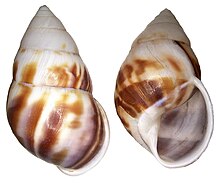Amphidromus
| Amphidromus | |
|---|---|
 |
|
| Abapertural and apertural view of the shell of Amphidromus perversus | |
| Scientific classification | |
| Kingdom: | Animalia |
| Phylum: | Mollusca |
| Class: | Gastropoda |
| (unranked): | clade Heterobranchia clade Euthyneura clade Panpulmonata clade Eupulmonata clade Stylommatophora informal group Sigmurethra |
| Superfamily: | Helicoidea |
| Family: | Camaenidae |
| Subfamily: | Camaeninae |
| Genus: |
Amphidromus Albers, 1850 |
| Diversity | |
| 87 species | |
Amphidromus is a genus of air-breathing land snails, terrestrial pulmonate gastropod mollusks in the family Camaenidae.
Amphidromus is a genus of arboreal pulmonate land snails. The shells of Amphidromus are relatively large, from one to three inches high, and colorful.
The genus may be characterized as follows: It has brightly colored, elongate conic shells, dextral or sinistral with one to three inches high with 5 to 8 whorls which increase regularly in size. The aperture is sublunate or auriform, without teeth or folds, height two-fifths to one-third that of shell. The peristome is expanded and reflected, sometimes thickened. Parietal callus is weak to well-developed. The umbilicus is open or closed. Color pattern is monochrome to variegated. The jaw is thin and weak with low flat ribs. The radula is with cusped teeth arranged in V-shaped rows and modified in typical arboreal pattern. The pallial region is sigmurethrous with very long, narrow kidney. Genitalia are camaenid, with long seminal receptacle, and short penis with low insertion of retractor muscle. The habitat is arboreal.
The shells of Amphidromus are relatively large and colorful and were among the first Indonesian land snails brought back to Europe; most specimens in collections were brought back by travelers or explorers during the 18th century. Comparatively little material has been gathered by malacologists. Several species and forms were described before 1800, generally with inadequate locality data. At least two kinds — Amphidromus laevus (Müller, 1774) and the form Amphidromus perversus f. aureus Martyn, 1784 — still have not been reported from a precise locality.
...
Wikipedia
